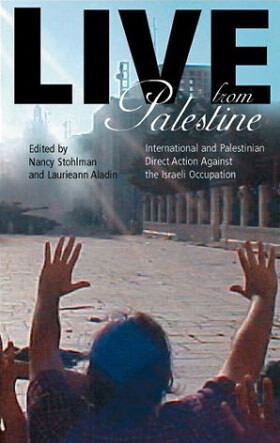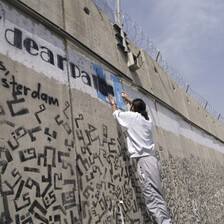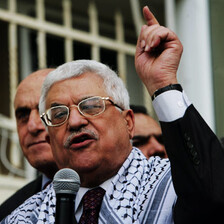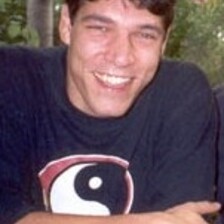1 December 2003

The cover of Live from Palestine. Click here to buy this book on Amazon.com.
In 2003, South End Press published a book entitled Live From Palestine: International and Palestinian Direct Action Against the Israeli Occupation, edited by Nancy Stohlman and Laurieann Aladin, with introductions by Noam Chomsky and Dr. Mustafa Barghouthi, co-founder of Grassroots International Protection for the Palestinian People.
The book contains contributions from two EI co-founders, Arjan El Fassed and Ali Abunimah, and reprinted several diary entries from The Electronic Intifada.
The following article by Arjan El Fassed from the book introduces The Electronic Intifada’s diary project, Live From Palestine, after which the book was titled. Reprinted with permission.
Live from Palestine: The Diaries Project
Internet cafes exist in most Palestinian cities and refugee camps, and Palestinians and international activists have made heavy use of the Internet to report otherwise unheard news and perspectives. Many Palestinians speak and write English, allowing their words to reach a wide Western audience. Counterpunch, Commondreams, the Electronic Intifada, the Palestine Chronicle, the Palestine Monitor, Indymedia, and numerous other websites have published regular eyewitness reports from the West Bank and Gaza, where Israeli forces deny journalists access to Palestinian areas under attack. Here, Arjan El Fassed, describes how the Internet has allowed Palestinians to communicate with each other and people around the globe. Several of the essays in this section were originally posted to the Electronic Intifada website (electronicIntifada.net).
Journalists and correspondents covering the Al-Aqsa Intifada since September 2000 have faced a variety of hazards from the Israeli army and militant Jewish settlers, including bullets, tear gas, shrapnel, and physical assault. Just within the first three weeks of April 2002, for example, attacks on press freedom in the Occupied Territories included: one journalist killed and seven wounded; four journalists detained and fifteen arrested; sixty journalists targeted by gunfire; twenty journalists roughed up or threatened; another twenty who had their passports, press cards, or equipment confiscated; ten Arab media offices occupied and ransacked; and one journalist deported. Israeli authorities also prevented foreign media access to various cities, towns, and villages on the West Bank declaring, for instance in the case of Ramallah, “The entire Ramallah area has been declared a closed military zone. No foreign citizens (including members of the media) are allowed to enter the closed zone. Anyone found in the closed zone henceforth will be removed.”[1]
Stephanie Saldana for the Daily Star, a Lebanese paper, wrote: “What [the Israeli authorities] failed to recognize is that the media is no longer limited to those with press passes. In the age of the Internet, anyone can become a journalist.”[1]
In that realm of thinking, an unprecedented new website, the Electronic Intifada, was created in October 2000. I, along with cofounders Ali Abunimah, Laurie King-Irani, and Nigel Parry, aimed to enable a growing network of human rights and media activists to challenge the myths, spins, and distortions about Palestinians and their rights disseminated by various official Israeli spokespersons and media outlets throughout Europe and North America.
According to Parry:
The main reason that the conflict has carried on as long as it has is simply because the Israelis have learned very well the importance of winning the war of words. The Internet has become a key new arena in which this occurs, not least because it overturns the tables on the traditional power structure of [corporate] media.[2]
The Internet highlights media’s direct and indirect roles in reinforcing representations of, and policies toward, Palestinians. It enables individuals throughout the world to visit sites reporting directly from Palestine, allowing them to compare the nature and depth of indigenous coverage to that of mainstream media.
In establishing the Electronic Intifada, we envisioned the Internet giving voice not only to concerned media activists but, more important, to the Palestinian people, who have so long been deprived of the opportunity to narrate what it is like to live under what was, until the United States invaded Iraq in 2003, the world’s last military occupation. Hence, we created a subsite within Electronic Intifada’s website, Live from Palestine: The Diaries Project, on March 29, 2002. Saldana’s review of the Diaries Project noted: “Intended as a news source, the site has slowly been transforming into a work of art, a human testimony of collective grief and a will to survive.”[1]
Indeed, Palestinians should have a means by which to narrate their own lives, hopes, and history. The Diaries site gives writers a space in which to record their opinions and reflections on historic events. It has been a valuable asset, an alternative source, and a needed human context to understand the realities of life under occupation.
Updated regularly, this citizens’ source contains on-the-ground accounts of the siege written by 38 individuals to-date, including doctors, aid workers, human rights activists, and anyone else who has managed to get access to the Internet—despite repeated power cuts and curfews—in various places throughout the West Bank and Gaza Strip. The entries are personal, sometimes emotional, mundane and exciting, literary and pedestrian. Residents upload their entries from home or Internet cafes, making their narratives immediately available for a wider, international, English-reading audience. Instead of lobbying the media, citizens confined to their homes in Ramallah, Nablus, Bethlehem, Gaza, and other places essentially become the media. The result is a diary series that “succeeds in deconstructing headlines and redefining them within a human context, reinforcing the fact that the current siege has transformed into an attack not only on militants, but on a civilian population.”[1]
The diary entries, by giving ordinary Palestinians the power to narrate, address the issues of human rights, humane values, justice, and equality. For some of the diary writers, it is a form of therapy. Telephone and Internet connections are their only links to the outside world. Catherine Cook, who works for the Palestinian section of the Defense for Children International, a human rights organization focused on children’s rights, described these connections as the only “grasp on sanity at this point.” Andrea Becker, the refugee coordinator at Oxfam Quebec, working in Ramallah, continuously writes about the many phone calls her center is receiving, from pregnant women needing to deliver, to families needing food, water, or medicine. On the second day of the invasion, which began on March 29, 2002, Becker wrote about a woman who had called in distress for assistance. Before Becker could convey the needed information to the young woman, however:
The phone line went dead; the land line cut. The battery on her mobile phone went dead hours ago; she hasn’t had electricity for two days. Before the lines cut we could tell her where the tanks were in Ramallah; where the tanks were moving. Ask her how much food she had left, how long her supplies might last. She could call other people in Ramallah, and find out where the Israeli troops were. The loud noises, the shelling, how close is it? What has been hit? Where are they?[3]
This woman, the subject of Becker’s entry, did not know the Israeli forces were coming into her area of Ramallah. She did not know they were going from house to house, chasing people. Becker and her colleagues could not stay on the phone and talk her through what she should say, what she could do. They couldn’t tell her how she should repeat over and over, as the Israeli soldiers bang or shoot or break her door down, that she is a woman, alone in the house, and that she is unarmed.
“And now,” Becker notes, “we are the ones who don’t know what is going on, or how she is faring. We don’t know if she has water, if she has food, and—when the soldiers stormed into her house—if she said the right thing.”[3]
Becker’s diary entry is just one example of the many immediate and heartfelt appeals to the world.
Putting tragedies, events, and experiences into words helps to ease the turmoil and defuse the terror. Writing provides a sense of control and understanding. For some, writing is a struggle, a matter of survival. As eyewitnesses to tomorrow’s news, we cannot hope to understand what is going on without access to alternative information resources. Live from Palestine: The Diaries Project represents a step in this direction—the closing of a gap between our daily experience on the ground and the different experience suggested by the media coverage that we critique. As Parry expresses:
With Israel’s current attempts to remove the witnesses from the scene of the crime, initiatives like this will become increasingly important. With the increasing ubiquity of information technology, these obstacles can be overcome.[4]
When Ariel Sharon launched a massive military offensive in the West Bank in late March 2002, the Israeli army used threats, intimidation, and lethal force to prevent journalists from covering its military actions. Where journalists cannot enter, the residents must take over. We do not need permission to narrate; it is our duty. If the world cannot be brought to Palestine, we have to bring Palestine to the world.
Endnotes
1. Stephanie Saldana, “Life and Death in Palestine,” The Daily Star, April 5, 2002.
2. Nigel Parry in Laurie King-Irani, “The Electronic Intifada,” CommonDreams, March 8, 2001. www.commondreams.org/views01/0308-03.htm
3. Andrea Becker, “The phone line went dead.” The Electronic Intifada, April 2, 2002. electronicIntifada.net/v2/article29.shtml.
4. Parry, “Eyewitness of Tomorrow’s News.” The Electronic Intifada, April 1, 2002. electronicIntifada.net/v2/article24.shtml.




